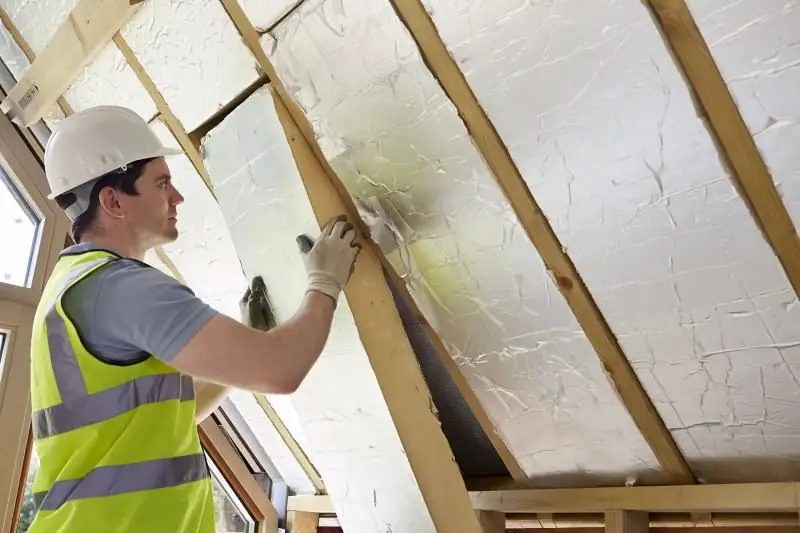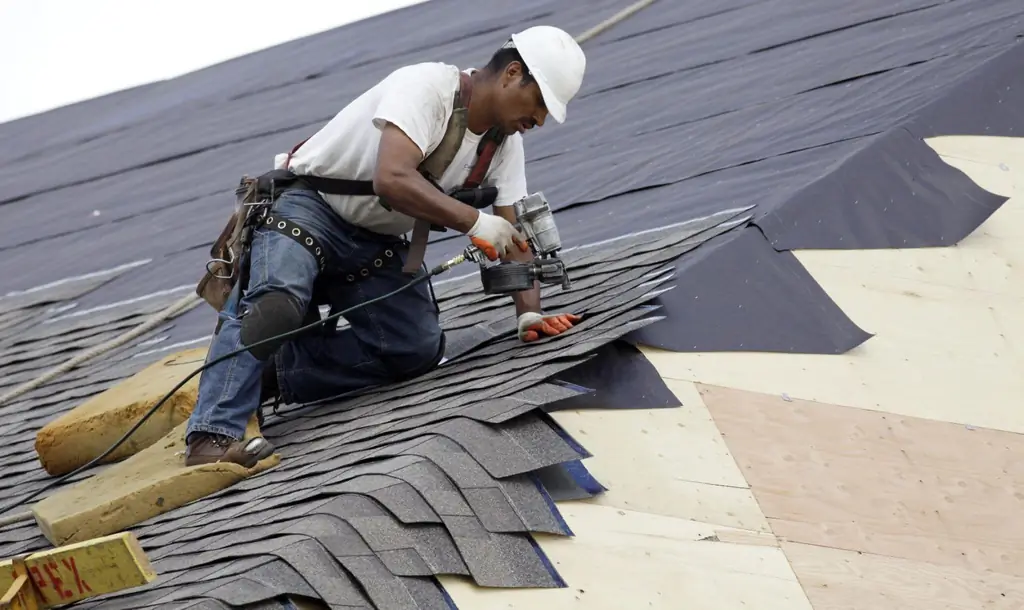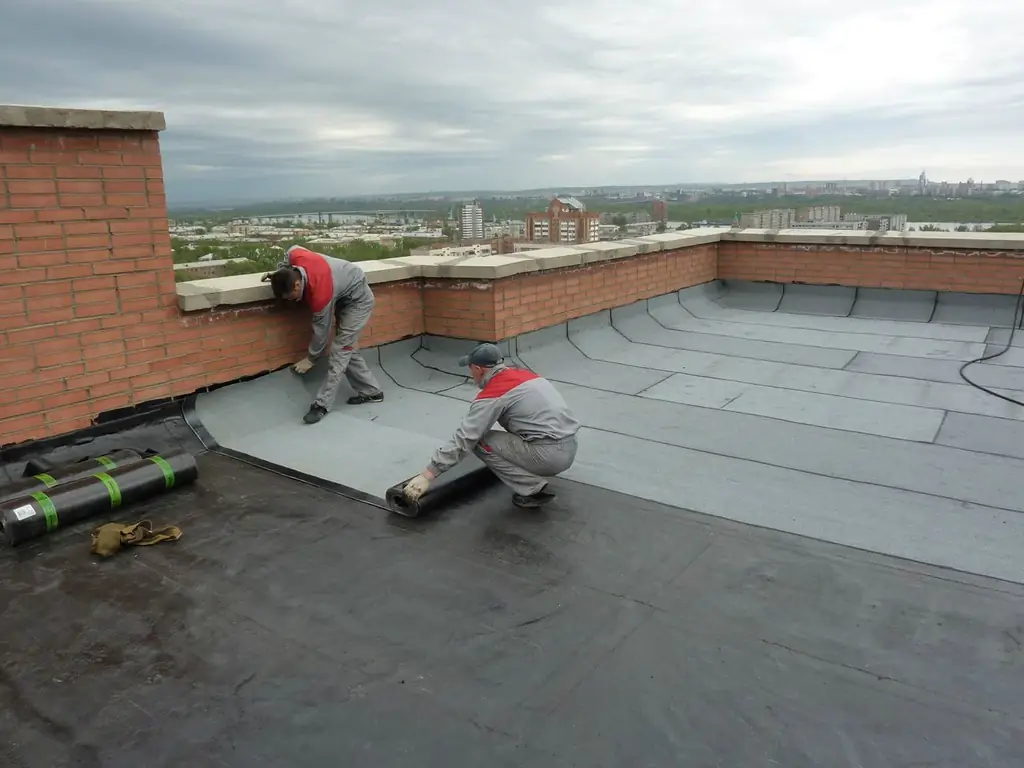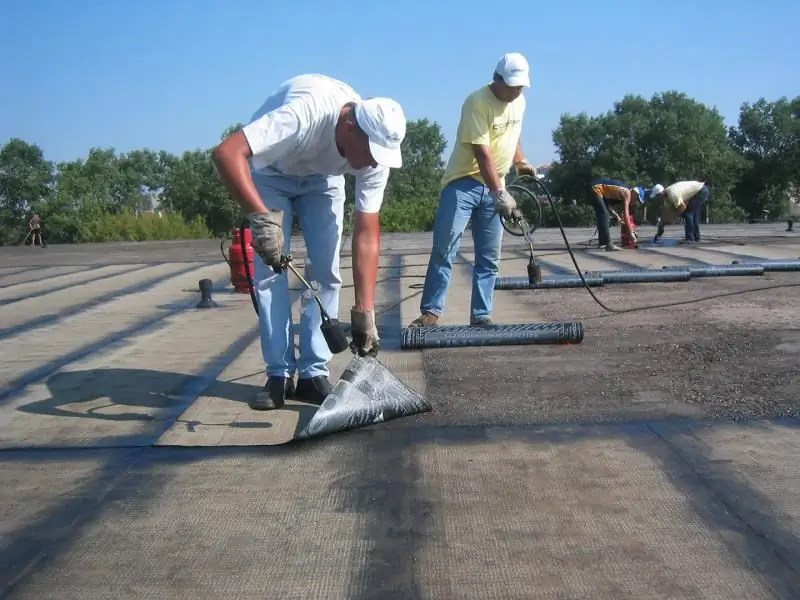
Table of contents:
- Author Bailey Albertson [email protected].
- Public 2023-12-17 12:53.
- Last modified 2025-06-01 07:32.
Insulation of the roof from the inside: methods and materials for arrangement with your own hands

In a house with an insulated roof it is always comfortable and requires less energy consumption for heating than for buildings with a roof without thermal insulation. Insulation of the structure from the inside allows you to ensure an optimal microclimate in the premises, but for this it is important to choose high-quality materials and methods of arrangement.
Content
-
1 Characteristics of insulation options
-
1.1 Mineral wool: properties and types
1.1.1 Video: insulation of the attic floor with mineral wool
-
1.2 Styrofoam or Styrofoam
1.2.1 Video: roof insulation with expanded polystyrene
-
1.3 Insulation with polyurethane foam
1.3.1 Video: roof insulation from the inside with polyurethane foam
- 1.4 How to choose the best insulation
-
-
2 Methods of roof insulation from the inside
2.1 Video: features of attic insulation
-
3 Insulation of the roof from the inside with mineral wool: technology features
- 3.1 Stages of roof insulation
- 3.2 Video: roof insulation with Isover material
Characteristics of insulation options
Arrangement of a heat-insulating layer from the inside of the roof, that is, from the attic side, is possible both at the construction stage and with a finished roof. Of particular importance is the variant of the material used for insulation. Manufacturers produce a variety of structures that differ in characteristics, method of application, cost and operating characteristics. To achieve a high level of thermal insulation, you need to familiarize yourself with the properties of materials and choose the optimal one, corresponding to climatic conditions.

Insulation is mounted from the inside of the roof and therefore there is no need to disturb the structure of the roofing cake
The range of roof heat insulators includes both classic and modern materials. The methods of their installation are different, but in any case, it is required to observe thoroughness and work technology. This will allow to insulate the roof with high quality and eliminate the need for repairs for a long period.
Mineral wool: properties and types
Mineral wool is a good and affordable thermal insulator for roofs. The material is presented in slabs or rolls of different thicknesses, characterized by durability and practicality in operation. In contact with the wood from which the roof rafters are made, the mineral wool does not form chemical reactions and does not contribute to the decay of the frame. The high degree of sound insulation distinguishes this material from many others.

Mineral wool in plates is easy to use
The range of mineral insulation includes options with different characteristics. For roof insulation, the material must have the following properties:
- the thickness of the mineral wool layer should be from 20 cm for the regions of the middle and colder strip of Russia;
- the service life of a quality structure is up to 50 years;
- density should be from 35 to 100 kg / m 3;
- semi-hard, but not loose or hard mineral wool is suitable for the roof;
- thermal conductivity coefficient - 0.045-0.056 W / m 2.

Mineral wool can have a reflective layer to enhance material properties
To ensure good protection of the attic from the cold, a mineral component of medium density is used. Many well-known manufacturers produce slabs or rolls designed specifically for roofing. Modern options have a reflective layer that is mounted inside the room. The shiny surface helps to retain heat in the home and prevents cold penetration. The boards can also be equipped with a vapor barrier film or superdiffuse membrane; materials consisting of layers of different densities are effective.
Video: insulation of the attic floor with mineral wool
Styrofoam or Styrofoam
White Styrofoam slabs are low cost and easy to find at a hardware store. Such material consists of compressed polystyrene foam granules and has high sound and heat insulation.

Installation of slabs does not require professional tools
Polyfoam in the form of slabs has the following characteristics that are optimal for a high-quality roof arrangement:
- high sound insulation of the room, even with a foam layer thickness of 2-3 cm;
- low water absorption prevents the structure from rotting;
- high density of the material provides wind protection;
- the optimal thickness of the expanded polystyrene layer for the roof in most regions is from 200 mm.

Styrofoam boards are affordable, but not durable
Despite the good sound and heat insulation properties, foam is impractical for insulating the roof of a residential building. This is due to the high fire hazard of the material, instability to ultraviolet light. At the same time, expanded polystyrene does not provide air circulation, creating an atmosphere with high humidity in the room.
Video: roof insulation with expanded polystyrene
Insulation with polyurethane foam
The structure of polyurethane foam is porous and has cells filled with a gaseous substance. The material is made from petrochemical products, contains polyols, polyisocyanates. This insulation has a structure with cells of different volume and wall thickness. Depending on this, there are hard, soft, very soft, elastic and other types of polyurethane foam.

Cured polyurethane foam is a porous structure with high elasticity
For insulation of the roof of a residential building, polyurethane foam with the following characteristics is optimal:
- density - 30-86 kg / m 3;
- thermal conductivity - 0.019-0.03 W / m;
- compliance with GOST 12.1.044 (slow-burning);
- water absorption not more than 1.2% of the total volume;
- layer thickness from 10 to 60 mm.

Polyurethane foam is applied in several layers, and their total thickness reaches 60-80 mm
The roof is arranged using liquid polyurethane foam, which is produced in cylinders or containers. With a large amount of work, special equipment is required, consisting of two barrels with different components of polyurethane foam, a spray device, a hose for transporting the composition. The product consists of two elements that mix during application and solidify, forming a resilient and porous foam.
Video: roof insulation from the inside with polyurethane foam
How to choose the best insulation
The choice of thermal insulation material for the roof is based not only on the climatic features and characteristics of the insulation, but also on the shape of the roof. This is due to the fact that it is not always convenient to mount plate or roll components. For example, spray-on polyurethane foam is suitable for hipped-roof and cone-shaped structures, with which it is easy to close even hard-to-reach gaps. Pitched roofs are easy to insulate with slab or roll materials, since they are mounted in the gap between the rafters.

There are a lot of roof options, but the choice of insulation is carried out taking into account the size and shape of the structure
The main features are:
- non-toxicity of insulation and safety for human health;
- incombustibility, optimal degree - G1;
- preservation of the geometric shape by the material regardless of changes in humidity, temperature;
- no chemical reaction between the heat insulator and the roofing material;
- frost resistance and low specific gravity.
Roof insulation methods from the inside
Thermal insulation of the roof allows creating a comfortable atmosphere in the house. This process can be carried out in several basic methods, which differ in the technology of work and the materials used.

The choice of insulation method depends on the purpose of the attic room
The method of insulation may depend on the purpose of the attic space. If the space will play the role of an attic, then the roof and floor should be carefully equipped. In the case when only the elimination of heat loss through the roof is required, then it is enough to insulate the attic floor. Depending on the suitable method, the necessary tools, equipment are prepared, and the vapor barrier is installed.

Full insulation of the attic also implies thermal insulation of the floor
The main ones are three methods of roof insulation, the features of which are expressed in the following:
- installation of insulation directly on the inner surface of the roof. For this method, slab or roll materials are suitable, which are placed in the space between the rafter legs, and then a small crate is mounted on which a vapor barrier film is attached. At the same time, there should be a gap of about 5 cm between the vapor barrier and the insulation for ventilation and moisture removal;
- the spray method involves the application of polyurethane foam using special equipment. Such a composition forms a foam that quickly hardens, but even gets into small cracks, preventing the penetration of cold. The tool is applied to the rafter system from the inside of the roof, and then a vapor barrier is mounted and the attic room is finished;
- for an unexploited attic, a floor insulation method is suitable. In this case, a complex of light logs is created, in the space between which expanded clay or foam glass is poured. Next, the rough floor is mounted. In this case, the roof remains "cold" and does not require insulation.
Video: features of attic insulation
Insulation of the roof from the inside with mineral wool: technology features
In addition to classic mineral wool, modern manufacturers present improved versions of basalt or fiberglass insulation. Such materials are similar to mineral wool, but have much higher technical characteristics than a simple version of the fibrous structure. At the same time, the installation technology is the same in each case and can be used for polystyrene, polystyrene foam and other thermal insulation boards.

Thermal insulation with slab materials is optimal for any pitched roofs
Before working on arranging the roof from the inside, you need to take into account such recommendations as:
- the joints of the insulation plates in adjacent layers are placed in a checkerboard pattern;
- if the total thickness of the heat insulator should be 20 cm, then you need to lay 2 layers of 10 cm, and not 4 of 5 cm;
- the material for insulation should not block the ventilation gaps;
- mineral wool slabs cannot be bent, which will lead to the rapid absorption of moisture by the material;
- they should fit as tightly as possible to each other and to the rafters.
Stages of roof insulation
Insulation work begins with an inspection of the rafter system. If rotten or damaged elements are present, they must be replaced with new ones. After that, all wooden parts of the structure are treated with an antiseptic, which will prevent rotting and extend the life of the insulation.

The rafters must be safe and sound
For work, you will need a sharp knife, tape measure, carnations, wooden blocks with a cross section of about 5x5 cm, strong synthetic thread and a furniture stapler with staples. Basic installation steps:
-
The waterproofing film is laid outside the rafter system, that is, under the roofing. Measure the distance between the rafter legs, cut the slabs or roll according to this width.

A roll of mineral wool for insulation The material is cut directly in the package, which is convenient and does not require unnecessary actions
-
The roll is rolled from top to bottom, tightly pressing the material to the rafters. If plates are used, then they are also carefully placed in the space between the rafter legs. The slots are sealed with assembly foam that is resistant to temperature and humidity extremes.

Laying mineral wool between the roof rafters Plates are laid tightly, and then bars are stuffed onto the rafters under the vapor barrier
-
The laid material is fixed by pulling the thread. For this, staples are stuffed on each rafter leg, the thread is fastened in a zigzag. A more efficient method is to install the beams across the rafters. These elements serve as the basis for a vapor barrier film, which is fastened with brackets and additionally fixed with slats, pulling well along the planes. Installation is carried out with an overlap of about 10 cm, the joints are connected with adhesive tape.

Roof vapor barrier from the inside The vapor barrier film is fixed with staples and additionally slats
Using this technology, you can lay plates of foam, foam and other similar materials. Previously, all the cracks are sealed with polyurethane foam, and there should be no holes in the waterproofing film that facilitate the penetration of moisture. This way you can avoid damage to the insulation and provide comfort in the room.
Video: roof insulation with Isover material
Arrangement of a heat-insulating layer on the roof can be carried out from the inside by observing the work technology. Plate materials are most convenient for DIY installation and therefore are in demand in private housing construction.
Recommended:
Insulation Of The Roof From The Inside With Foam: Description And Characteristics Of The Material, Installation Stages + Video And Reviews

How to choose foam for roof insulation. How to properly form a roofing cake. Styrofoam stacking and cutting methods
Repair Of A Soft Roof, Including A Description Of Its Main Stages, As Well As Material And Tools For Work

Diagnostics of the condition of the soft roof. Repair types and their main features. A brief overview of roofing materials and recommendations for their selection
Flat Roof Repair, Including A Description Of Its Main Stages, As Well As Material And Tools For Work

A brief description of the types of flat roof repair. Recommendations for the selection of roofing materials. Technology for eliminating various defects on flat roofs
Rolled Roof Repair, Including A Description Of Its Main Stages, As Well As Material And Tools For Work

The main types of repair work. Preparation for work and general safety precautions. Step-by-step instructions for performing major and current repairs
Thermal Insulation Of The Roof And Its Types With A Description And Characteristics, As Well As Features Of Materials And Installation

Description of the types of roof insulation, as well as the main materials for insulation and their properties. How to properly install thermal insulation on the roof and how to work
